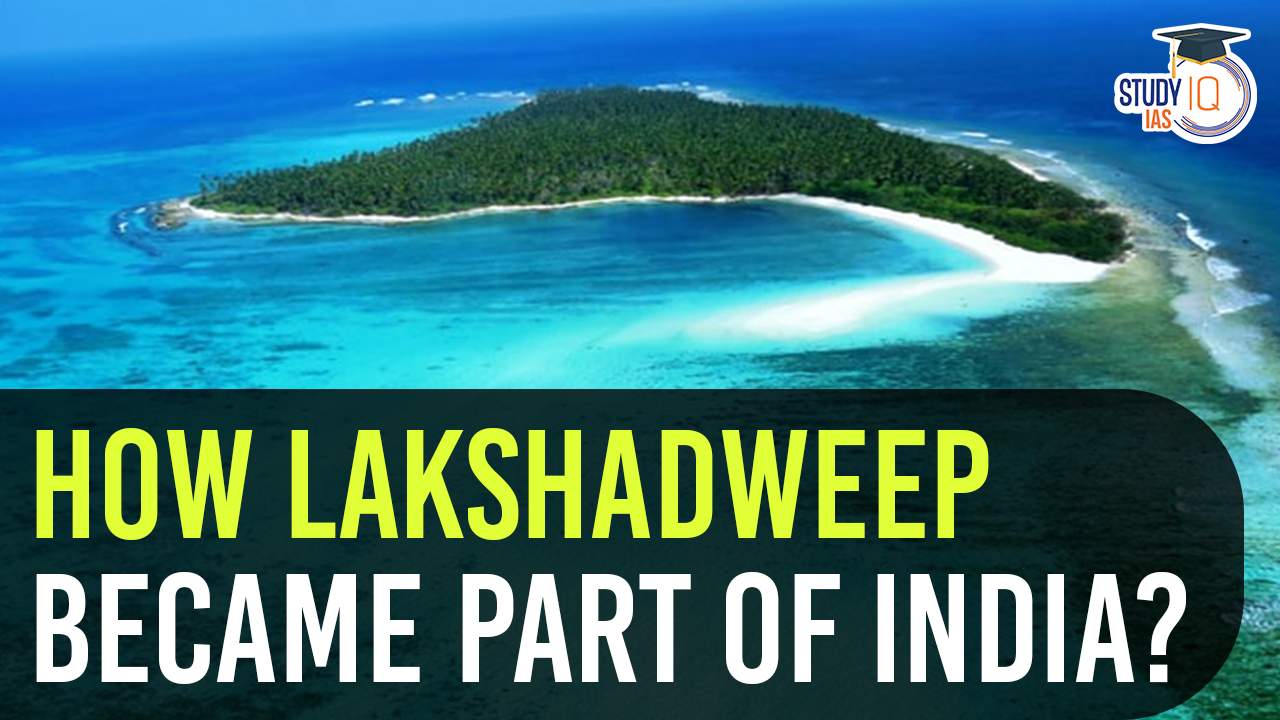Table of Contents
How Lakshadweep Became Part of India?
In 1947, previously under British direct administration, Lakshadweep Island was integrated into India’s sovereignty following independence. The islands were initially merged into the Madras Presidency in 1956 and included in Kerala. On November 1, 1956, a key decision separated Lakshadweep from the Malabar District, establishing it as a distinct union territory. Sardar Patel played a vital role in this integration, contributing to the islands becoming an integral part of India’s political landscape.
History of Lakshadweep
Cheraman Perumal’s Role and Legendary Settlement
- The last king of Kerala, Cheraman Perumal, is believed to have initiated the settlement.
- Post-conversion to Islam, he left for Mecca, leading to the islands’ first settlement.
- Search parties, including one led by the Raja of Cannanore, faced a shipwreck on Bangaram Island.
Arrival of Islam and St. Ubaidullah’s Mission
- Islam arrives in the 7th century through St. Ubaidullah.
- Ubaidullah, after a divine dream in Mecca, propagates Islam on Amini Island.
- Overcoming opposition, miracles, and successful conversion of multiple islands.
- Ubaidullah’s grave on Amini remains a revered sacred site.
Portuguese Intrusion and Islander Resistance
- Portuguese arrival in the 16th century, seeking Lakshadweep’s coir.
- Amini islanders resist Portuguese intrusion, allegedly poisoning invaders.
- Successful thwarting of Portuguese attempts to exploit resources.
Transition of Sovereignty and Tipu Sultan’s Intervention
- Despite conversion to Islam, sovereignty initially with Hindu Rajah of Chirakkal.
- Muslim house of Arakkal assumes control in the mid-16th century.
- Islanders seek Tipu Sultan’s assistance in 1783, resulting in the division of suzerainty.
- Significant shift in political landscape with Tipu Sultan’s involvement.
British Colonial Rule and Political Manipulations
- Portuguese arrival elevates Lakshadweep’s strategic importance.
- British East India Company took control in 1799 after the Battle of Seringapattom.
- Lakshadweep Regulation of 1912 was implemented, emphasizing economic interests over governance.
- Islands were sequestered, marking a period of exploitation and plunder.
Formation of Lakshadweep Union Territory
- Lakshadweep Union Territory was officially established in 1956.
- Administrative changes following British rule.
- Official naming of the territory as Lakshadweep in 1973, signifying its evolving political identity and cultural heritage.
Lakshadweep Union Territory
| Aspect | Details |
| Location | Lakshadweep is a union territory of India, situated in the Arabian Sea. |
| Island Count | Comprises 36 islands known for scenic beauty, coral reefs, lagoons, and beaches. |
| Water Sports | A popular destination for water sports: snorkelling, windsurfing, scuba diving, surfing, water skiing, and yachting. |
| Name Change | Originally known as Laccadive, Minicoy, and Amindive Islands, renamed Lakshadweep in 1973 by an act of Parliament. |
| Size | Covers a surface area of 32 square kilometers. |
| Administration | Led by an administrator appointed by the president of India; a single district with 10 subdivisions; falls under the jurisdiction of the Kerala High Court. |
| Official Language | Malayalam is the official language. |
| Largest Island | Andrott Island is the largest, spanning 4.90 square kilometres. |
| Other Islands | Agatti, Amini, Bitra, Chetlat, Kadmat, Kalpeni, Kavaratti, Kiltan Islands, among others. |
How are Lakshadweep Islands Formed?
The Lakshadweep Islands are primarily coral atolls, which means they are formed through the accumulation and growth of coral reefs. The geological processes leading to the formation of these islands involve several stages:
- Volcanic Activity: The initial stage involves underwater volcanic activity. Volcanic activity creates a rising seafloor that eventually reaches the ocean’s surface.
- Coral Growth: Over time, coral polyps, which are tiny marine organisms, attach themselves to the submerged volcanic rock. These corals extract calcium carbonate from the seawater and secrete it to form hard skeletons, creating the foundation of coral reefs.
- Reef Building: As more and more corals grow and die, their skeletons accumulate, forming a framework for the development of a coral reef. The reefs continue to grow both vertically and horizontally.
- Atoll Formation: As the volcanic island subsides or erodes over geological time, the coral reef grows upwards. Eventually, a lagoon is formed in the centre, surrounded by a ring or chain of coral islands. The lagoon is often shallow and may have sandy patches.
In the case of Lakshadweep, the islands are part of the broader Lakshadweep-Chagos Archipelago, and their formation is linked to the geological processes described above. Coral atolls like those in Lakshadweep are delicate ecosystems highly dependent on environmental factors such as sea level, water temperature, and wave action.
How Lakshadweep Became Muslim Majority?
The demographic composition of Lakshadweep, with a Muslim majority, is primarily a result of historical factors and cultural influences. The conversion of the local population to Islam played a significant role in shaping the religious composition of the islands. Here are some key factors contributing to Lakshadweep’s Muslim majority:
- Historical Trade and Contacts: The islands of Lakshadweep have a history of maritime trade and contacts with various cultures. The influence of Arab traders in the region, especially during the medieval period, played a crucial role in the spread of Islam.
- Arab Influence and Settlements: Arab traders and sailors were known to establish settlements and engage in trade along the coastal areas of the Indian subcontinent, including Lakshadweep. Through interactions with the local population, many people embraced Islam, and the cultural and religious practices of the Arab traders influenced the islanders.
- Sufi Missionaries: The spread of Islam in Lakshadweep was also facilitated by the efforts of Sufi missionaries who travelled to different regions to promote the teachings of Islam. Their influence, combined with the appeal of the Sufi mystic tradition, contributed to the conversion of local communities.
- Cultural Integration: Over time, the cultural and social integration of the converted communities into the broader Islamic framework solidified the Muslim identity of the majority of the population in Lakshadweep.
- Intermarriage and Social Dynamics: Intermarriage between Muslim families and the assimilation of cultural practices further contributed to the consolidation of a Muslim majority in Lakshadweep. Social dynamics and community ties often play a crucial role in shaping religious affiliations.
It’s important to note that the historical processes leading to the Muslim majority in Lakshadweep are complex and multifaceted. The island’s history is shaped by a combination of trade, cultural exchanges, religious missions, and local socio-cultural dynamics over an extended period.


 List of Awards and Honours Received by N...
List of Awards and Honours Received by N...
 List of GI Tag Products in India 2025, S...
List of GI Tag Products in India 2025, S...
 Hurun Global Unicorn Index 2025: Key Hig...
Hurun Global Unicorn Index 2025: Key Hig...





















